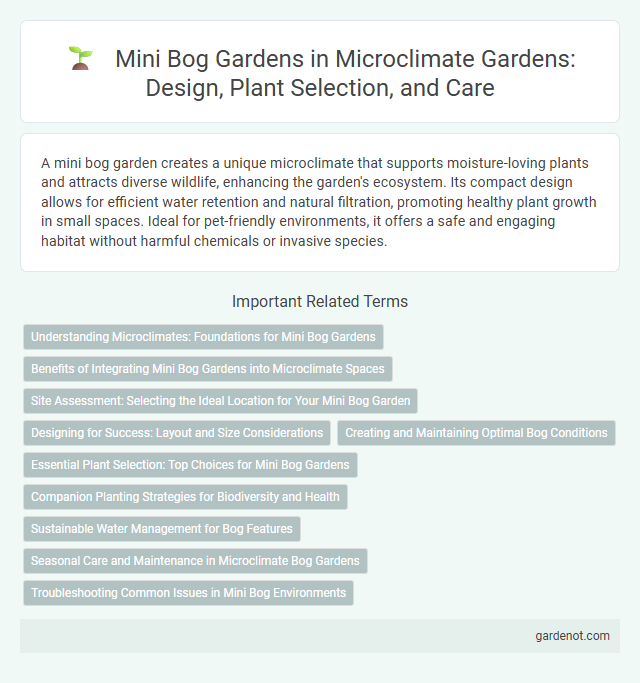A mini bog garden creates a unique microclimate that supports moisture-loving plants and attracts diverse wildlife, enhancing the garden's ecosystem. Its compact design allows for efficient water retention and natural filtration, promoting healthy plant growth in small spaces. Ideal for pet-friendly environments, it offers a safe and engaging habitat without harmful chemicals or invasive species.
Understanding Microclimates: Foundations for Mini Bog Gardens
Mini bog gardens thrive by leveraging specific microclimate conditions such as consistent moisture, partial shade, and well-draining acidic soils. Understanding microclimates involves analyzing factors like sunlight exposure, humidity levels, and air circulation to create a stable environment for moisture-loving plants like sphagnum moss, pitcher plants, and sedges. Tailoring these environmental variables ensures optimal growth and sustainability in compact bog garden designs.
Benefits of Integrating Mini Bog Gardens into Microclimate Spaces
Integrating mini bog gardens into microclimate spaces enhances biodiversity by creating a unique wet habitat that supports moisture-loving plants, insects, and amphibians. These compact, water-retentive gardens improve air quality and help regulate temperature fluctuations, contributing to a balanced micro-ecosystem. Their ability to efficiently manage excess water provides natural drainage solutions, reducing soil erosion and promoting sustainable urban gardening.
Site Assessment: Selecting the Ideal Location for Your Mini Bog Garden
A mini bog garden thrives in a low-lying area with consistently moist soil and partial shade to prevent excessive drying. Conducting a thorough site assessment includes checking soil pH, drainage patterns, and water availability to ensure the location can sustain wetland conditions. Selecting a site near natural water sources or incorporating a water retention system supports the microclimate necessary for bog plants to flourish.
Designing for Success: Layout and Size Considerations
Designing a mini bog garden requires careful attention to layout and size to ensure proper water retention and plant health. A compact area of 3 to 6 square feet with a slight depression can create the necessary moisture levels for bog plants like pitcher plants and sphagnum moss. Incorporating layers of sand, clay, and organic matter promotes effective drainage and mimics natural bog conditions for optimal growth.
Creating and Maintaining Optimal Bog Conditions
Establishing a mini bog garden involves selecting a location with partial shade and ensuring consistent moisture through a combination of soil amendments like sphagnum peat and sand for optimal water retention and drainage. Maintaining an ideal acidic pH between 4.5 and 6.0 supports native bog plants such as carnivorous species, sedges, and mosses, which thrive in nutrient-poor, wet environments. Regular monitoring of water levels and periodic removal of invasive or overgrown plants is crucial to preserve the delicate microclimate and enhance biodiversity within the mini bog ecosystem.
Essential Plant Selection: Top Choices for Mini Bog Gardens
Essential plant selection for mini bog gardens includes moisture-loving species such as carnivorous pitcher plants (Sarracenia), marsh marigolds (Caltha palustris), and dwarf sweet flag (Acorus gramineus). Sphagnum moss serves as a foundational substrate, retaining moisture and supporting nutrient-poor conditions ideal for bog plants. Incorporating native sedges (Carex spp.) enhances biodiversity while maintaining the delicate microclimate essential for a thriving mini bog ecosystem.
Companion Planting Strategies for Biodiversity and Health
Mini bog gardens thrive by utilizing companion planting strategies that enhance biodiversity and promote healthy growth. Selecting moisture-loving plants like sedges, carnivorous plants, and moisture-tolerant perennials creates a balanced ecosystem that supports beneficial insects and improves soil health. Incorporating native species such as marsh marigold and sweet flag ensures natural pest resistance and nutrient cycling in the microclimate garden.
Sustainable Water Management for Bog Features
A mini bog garden utilizes sustainable water management by incorporating rainwater harvesting and natural filtration systems to maintain consistent moisture levels. Native bog plants, such as sphagnum moss and sedges, thrive in these water-retentive environments, promoting biodiversity and reducing runoff. Layered substrate with organic matter enhances water retention and supports microhabitat stability essential for bog features.
Seasonal Care and Maintenance in Microclimate Bog Gardens
Seasonal care in microclimate mini bog gardens involves managing water levels to mimic natural wetland conditions, essential for plant health during dry or cold periods. Regular removal of dead foliage in spring prevents decay and supports healthy new growth, while mulching helps maintain soil moisture and temperature stability. Monitoring for pests and adjusting shade or sunlight exposure based on seasonal changes optimizes the microclimate, ensuring a thriving bog environment year-round.
Troubleshooting Common Issues in Mini Bog Environments
Mini bog gardens often face challenges such as poor drainage, algae growth, and plant stress due to inconsistent moisture levels. Ensuring proper water circulation and selecting moisture-tolerant plants like Sphagnum moss and carnivorous species can alleviate these issues. Regular monitoring of pH and nutrient balance helps maintain an optimal microclimate for thriving bog flora.
Mini bog garden Infographic

 gardenot.com
gardenot.com